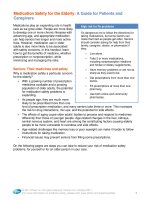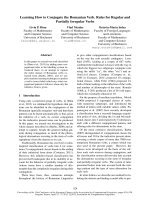the handy answer book for kids and parents
Bạn đang xem bản rút gọn của tài liệu. Xem và tải ngay bản đầy đủ của tài liệu tại đây (8.84 MB, 403 trang )
THE
KIDS
BOOK
(and Parents)
Judy Galens and Nancy Pear
for
ANSWER
HANDY
THE
HANDY
ANSWER
BOOK
for
KIDS
(and Parents)
Also from Visible Ink Press
The Handy Anatomy Answer Book, ISBN 978-1-57859-190-9
The Handy Answer Book for Kids (and Parents), ISBN 978-1-57859-110-7
The Handy Biology Answer Book, ISBN 978-1-57859-150-3
The Handy Geography Answer Book, ISBN 978-1-57859-062-9
The Handy Geology Answer Book, ISBN 978-1-57859-156-5
The Handy History Answer Book, ISBN 978-1-57859-170-1
The Handy Math Answer Book, ISBN 978-1-57859-171-8
The Handy Ocean Answer Book, ISBN 978-1-57859-063-6
The Handy Physics Answer Book, ISBN 978-1-57859-058-2
The Handy Politics Answer Book, ISBN 978-1-57859-139-8
The Handy Presidents Answer Book, ISBN 978-1-57859-167-1
The Handy Religion Answer Book, ISBN 978-1-57859-125-1
The Handy Science Answer Book
®
, ISBN 978-1-57859-140-4
The Handy Sports Answer Book, ISBN 978-1-57859-075-9
The Handy Supreme Court Answer Book, ISBN 978-1-57859-196-1
The Handy Weather Answer Book
®
, ISBN 978-0-7876-1034-0
Please visit us at visibleink.com
.
THE
Judy Galens and Nancy Pear
BOOK
KIDS
ANSWER
HANDY
Detroit
for
(and Parents)
The Handy Answer Book™
for Kids (and Parents)
COPYRIGHT © 2002 BY VISIBLE I NK PRESS
®
Photos used by permission of Corbis and Field Mark Publications
This publication is a creative work fully protected by all applicable copyright laws, as well as by misappropriation, trade
secret, unfair competition, and other applicable laws.
No part of this book may be reproduced in any form without permission in writing from the publisher, except by a review-
er who wishes to quote brief passages in connection with a review written for inclusion in a magazine or newspaper.
All rights to this publication will be vigorously defended.
Visible Ink Press®
43311 Joy Rd., #414
Canton, MI 48187-2075
Visible Ink Press and The Handy Answer Book are trademarks of Visible Ink Press LLC.
Most Visible Ink Press books are available at special quantity discounts when purchased in bulk by corporations, organi-
zations, or groups. For more information, contact Special Markets Director at (734) 667-3211 or at visibleink.com.
Art Director: Mary Claire Krzewinski
Typesetting: The Graphix Group
ISBN 1-57859-110-4
Printed in the United States of America
All rights reserved
10 9 8 7 6 5
Library of Congress Cataloging-in-Publication Data
Galens, Judy, 1968-
The handy answer book for kids (and parents) / Judy Galens
and Nancy Pear.
p. cm.
Includes index.
Summary: Answers a variety of questions about such topics as
nature, weather, geography, city and country life, technology, family
life, death, and disabilities.
ISBN 1-57859-110-4 (pbk.)
1. Children’s questions and answers. [1. Questions and answers.]
I. Pear, Nancy. II. Title.
AG195 .G25 2001
031.02—dc21 2001005608
CIP
With some preliminary experience answering a barrage of whos, wheres, whats, and
whys coming from her young son Graham, Judy Galens was glad of the opportunity
this book gave her to satisfy her own curiosity and prepare for life as the Answer Mom.
Judy has worked on a wide array of reference books for kids and adults, covering sub-
jects from world music to food festivals, from hockey to weather. She has edited a
multivolume reference work on the Middle Ages, and she recently co-authored a book
for young people called Artists.
Nancy Pear wishes that she had had some of the information contained in The
Handy Answer Book for Kids right at her fingertips when she was raising her own very
inquisitive child a while back. “He asked so many questions!” she recalls. Nancy has
worked as an author and editor of reference books for almost 20 years and has written
several works for young people. These include three books on explorers and discover-
ers and a three-volume set on strange phenomena.
About the Authors
v
INTRODUCTION xi
A
CKNOWLEDGMENTS xv
EARTH, SKY, AND
BEYOND . . . 1
Up above the World So High . . . Weather Basics . . .
Features of Planet Earth
WORLD TOUR . . . 49
Geography Facts . . . Life in the Big City . . .
Down on the Farm
ME, MYSELF,
AND I . . . 77
Growing Up . . . The Brain . . . Bones and Muscles . . .
Hair Today, Gone Tomorrow . . . The Skin I’m In
. . . Blood Matters . . . Hearing, Seeing, and
Smelling . . . Bathroom Talk . . . Feed Me . . .
Open Wide . . . What’s Up, Doc? . . . Sleepy Time
Contents
vii
OUR ANIMAL
NEIGHBORS . . . 133
Odds and Ends . . . Amazing Animal Behavior . . .
Insects, Spiders, and Worms . . . Fish and Other
Sea Creatures . . . Reptiles . . . Amphibians . . .
Birds . . . Mammals . . . A Day at the Zoo
TREES, FLOWERS,
AND OTHER GREEN
STUFF . . . 201
Plant Basics . . . Seed Facts . . . Flowers . . . The
Dark Side of Plants . . . Plants in Extreme Envi-
ronments . . . Spore-Bearing Plants . . . Trees . . .
Plants As Providers
HOW THINGS
WORK . . . 233
Transportation . . . Communication . . . Image Mak-
ers and Picture Takers . . . Lights and Lasers . . . Hot
and Cold . . . Energy
HOME LIFE AND
SCHOOL DAYS . . . 263
Around the House . . . Playing It Safe . . . Neigh-
borhood Transportation . . . Household Pets . . .
School Daze
MY FAMILY AND
FRIENDS . . . 297
Family Members . . . Getting Along . . . Death and
Dying
viii
ODDS AND
ENDS . . . 321
Food Trivia . . . Clothing . . . Keeping Track of
Time . . . American Symbols and Government
. . . Disabilities . . . Substance Abuse and Addic-
tion . . . Environmental Issues . . . Dinosaurs and
Fossils . . . Amazing Science
FOR MORE INFORMATION 365
I
NDEX 369
ix
CONTENTS
Why present information in a question-and-answer format? Because anyone who has
ever been a kid, or had a kid, or hung out with a kid knows that asking questions is
what kids do. It happens to be a great way to find out about the world around you.
Kids have an insatiable hunger for information and a curiosity that winds its way
down every road. And it’s an adult’s job to help satisfy that yearning for learning—by
answering questions when you know how or by pointing kids in the direction of a
good reference book when you don’t.
Written with a child’s imagination in mind, The Handy Answer Book for Kids
(and Parents) is not comprehensive or exhaustive. Naturally we couldn’t (and
wouldn’t want to) anticipate every burning question a kid might have. But it does pro-
vide lots of intriguing information on many different topics. Consider The Handy
Answer Book a starting point, a launching pad that will send an inquisitive mind in
many different directions (not all at once, we hope). Or think of it as a fun way to
spend a few hours, flipping from page to page and learning new nuggets of trivia with
which to impress your friends.
We focus on subjects that are front-and-center in a child’s world, things that are
parts of kids’ daily lives or that spark their imaginations—from the stars twinkling over-
head to earthworms burrowing into the earth. By the way, do you know why stars seem
to twinkle? Or how big Earth is? Can you answer the ever-popular question, Why is the
sky blue? The “Earth, Sky, and Beyond” chapter provides answers to such questions as
well as covering weather-related phenomena (What is a hurricane? A tornado? Light-
ning?) and various features of our planet like rainforests, deserts, oceans, and volcanoes.
“World Tour” takes you on a journey around the globe, delivering answers to
intriguing questions like which country is the smallest (Vatican City) and which is the
largest (Russia). “World Tour” also gives details about different cultures throughout
the world, explaining why we have different religions, why people speak different lan-
guages, and which language is spoken by the most people in the world (Mandarin Chi-
nese). You can also compare the starkly different lifestyles of those who live amid the
Introduction
xi
bustle of a city and those who work the land. Speaking of farm life, do you know why
so many barns are painted red? Or why horses sleep standing up?
Perhaps the most interesting subject for kids (and adults too) is the sometimes
mysterious workings of their own bodies, particularly as they pick their way through
the minefield of adolescence. “Me, Myself, and I” addresses the many changes a kid’s
body goes through and covers the body’s basic functions, from how muscles work to
why knuckles crack. And we don’t shy away from the less appealing (or more appeal-
ing, depending on your age and point of view) aspects of the human body, answering
questions about sweat, pimples, warts, scabs, vomit, and the crusty bits that some-
times form in the corners of your eyes while you sleep.
From a very young age, children become aware of and fascinated by animals, and for
many of us that fascination continues throughout our lives. “Our Animal Neighbors”
answers scores of questions about animals of all kinds, from the tiniest insects and bee-
sized bats to the largest land animal (the African elephant) and the biggest animal that
has ever lived (the blue whale). Sometimes learning one small fact—like why penguins
have their unique black-and-white coloring—can inspire us to look around and see
things a bit differently. In “Trees, Flowers, and Other Green Stuff,” readers will learn that
plants are more than just attractive ways to decorate a yard; all animal life (that includes
humans!) depends on plants, and their life systems are complex and amazing. Looking for
a concise explanation of photosynthesis? Look no further. Do you wonder about the dif-
ference between a plant and a weed? Wonder no more. Have you always wanted to know
what the biggest flower in the world is? It’s a blossom with the lovely name (and equally
lovely smell) of stinking corpse lily, and it grows to be nearly three feet wide.
All of us—young and not so young—use numerous high-tech tools and gadgets
every day. It’s hard to imagine life without cellular phones and e-mail, not to mention
airplanes, televisions, and light bulbs. But what miracle of technology makes these
items function? The chapter “How Things Work” explains it all. Did you know that a
photocopier relies on static electricity to work? And what is static electricity, anyway?
Have you ever wondered how an X ray works, or how a submarine can submerge and
then rise in the water?
The chapter “Home Life and School Days” addresses such critical questions as,
How can I get a bigger allowance? Why do I have to go to school? It answers queries
being asked in neighborhoods everywhere: How does a bicycle work? Why do dogs wag
their tails? Why do I have to do homework? “My Family and Friends” helps kids define
the roles of various family members—siblings, parents, stepparents—and explains the
value of things like telling the truth, behaving politely, and being a good sport. That
chapter also anticipates some of the more difficult questions children ask about grow-
ing old and dying.
And finally, “Odds and Ends” houses the information that doesn’t quite fit any-
where else but still is intriguing and important. Do you know why popcorn pops and
xii
soda pop fizzes? If you’ve ever wanted to know why we have times zones and daylight
saving time and what the International Date Line is, you can find out here. “Odds and
Ends” also covers several topics related to the U.S. government and national symbols,
explaining why the Statue of Liberty was built and why the bald eagle is the official
American symbol. Here you can learn about various disabilities and how people struc-
ture their lives around them. This chapter also covers the difficult subjects of sub-
stance abuse and addiction and explores such environmental issues as global warm-
ing, acid rain, and fossil fuels. The chapter concludes with discussions about fossils
and dinosaurs, answering questions about what dinosaurs ate, which ones were the
largest, and why they became extinct.
The Handy Answer Book for Kids explores numerous topics of interest to kids and
helps parents provide answers that go beyond “because” and “it just is” and “I don’t
know.” The chapters are divided up into manageable subsections, and a detailed sub-
ject index offers an additional avenue for accessing information. The section called
“For More Information” provides a list of books and web sites that can help satisfy
kids’ appetites for knowledge. And more than 120 photographs spread throughout the
book illustrate concepts and enliven the text.
It’s often said that young children are like sponges, soaking up an amazing array
and depth of information at a mind-spinning rate. Part of this rapid learning rate can
be explained by physiological developments, but little knowledge would be possible
without a sense of wonder and interest. And while those qualities can be found in
abundance in most children, they are by no means the exclusive province of the
young. If we’re lucky, we continue to feel the excitement of learning new things and
deepening our understanding for our entire lives.
xiii
INTRODUCTION
I owe heartfelt thanks to many people who contributed in some way to the completion
of this book. Thanks to Rebecca Nelson Ferguson—a person I’m proud to claim as a
colleague and more proud to acknowledge as a friend—for suggesting me as a worthy
candidate for this job. And thanks to Marty Connors for taking her up on that sugges-
tion. Marty and business partner Roger Janecke also deserve congratulations for the
perseverance and downright willfulness that helped raise Visible Ink Press from the
ashes. My appreciation goes to the many authors and editors of the other Handy
Answer Books, whose works provided interesting information and enlightening expla-
nations as well as an exemplary standard for all Handy Answer Books to come. A special
thanks goes to my co-author, Nancy Pear, who unearthed a lot of amazing information
for The Handy Answer Book for Kids (and Parents) and displayed a gift for presenting
complicated concepts in a straightforward, comprehensible, and entertaining way.
Thank you to my friend Jeff Hermann, who wore not one but two hats for this pro-
ject—that of copy editor and of photo editor. Great job on both counts. Your patience
with my last-minute additions was impressive. I’d also like to acknowledge the
tremendous contributions of the two sources for this book’s photographs: Rebecca
Wallace of Corbis and Robert J. Huffman of Field Mark Publications. Thanks are also
due to Terri Schell for attentive proofreading, Larry Baker for compulsive indexing,
Marco Di Vita for quality typesetting, and Mary Claire Krzewinksi for another beautiful
cover design. And thanks to Gonzalo Ferreyra, a dad well-versed in trying to answer
juvenile queries, for first suggesting the concept of this book.
I’d like to express my gratitude to and love for my family members, particularly my
mother, Jane Galens, whose love, energy, and continual quest for knowledge are inspir-
ing; and my in-laws, Barbara and Bob Narins, who provided (as always) unconditional
support, enthusiasm, and a few handy answers. My dear friends offered ideas and sin-
cere interest, and they patiently allowed me to inundate them with things I learned
while researching this book. Teacher extraordinaire Amy Goldman was especially gen-
erous with advice and insight. Jo-Lynne Rosenstein went the extra mile (as usual), pro-
Acknowledgments
xv
viding me with several bags of books collected over her many years of teaching children
(and being a mom). I wish to thank my wonderful husband, Brigham Narins, whose
sage advice, unflagging support (technical and otherwise), and editorial acumen have
saved the day on many occasions. And finally, I’d like to dedicate my part of this book to
my son, Graham Galens Narins, a continual source of wonder and joy (and a master of
the unending string of questions).
— Judy Galens
As a twenty-year veteran of the reference book business, I found writing The Handy
Answer Book for Kids (and Parents) my most challenging project. This was in no
small part due to the fact that the book was terminated at one point because of corpo-
rate downsizing. Visible Ink Press received its walking papers, and all works-in-
progress—even those approaching completion, like Handy Kids—were unceremoni-
ously shelved. It would take the great tenacity of Marty Connors to resurrect the
imprint and, over time, to bring the project to a happy conclusion.
Handy Kids was also one of the most fun projects I have undertaken, and there
are many people connected with it whose contributions I would like to gratefully
acknowledge. I would like to thank Rebecca Nelson Ferguson, who suggested me for
the job, as well as Julia Furtaw, who got me started on the somewhat daunting task of
defining the scope and providing the questions that we thought kids were pondering. I
would like to especially thank my editor, Dean Dauphinais, who was calmly supportive
throughout the many challenges I encountered, and who was an understanding advo-
cate when the book was unexpectedly scuttled. I am grateful, too, to my many friends,
whose suggestions for and interest in the book were unflagging, and who earnestly lis-
tened to the mountains of trivia I shared while writing it.
I feel deep and profound gratitude for my talented co-author, Judy Galens. She
gamely saw the project through to completion during its second incarnation, when I
could not. She enlarged and completed the work and dealt with countless other matters
so important to its publication. With Handy Kids in her very capable hands, I was able to
turn all my attention to one of the sad exigencies of life—the passing of a loved one.
And it is to my loved ones, finally, that I wish to express my greatest thanks: To
Brad Pear, my dear husband of more than twenty-five years, who has always been my
rock throughout every endeavor, and—at the same time—my soft place to fall. Your
gift for finding information over the web proved invaluable during this project. And to
my son Winston. The once inquisitive little boy has become a man that I greatly
admire, someone who continues to pursue his enthusiasms headlong—and who
expects nothing less of his mother.
—Nancy Pear
THE
HANDY
ANSWER
BOOK
for
KIDS
(and Parents)
UP ABOVE THE WORLD SO HIGH
What is air?
Air is a mixture of gases that circle Earth, kept in place by gravity. Air makes up
Earth’s atmosphere. The air we breathe is 78 percent nitrogen gas, 21 percent oxygen,
0.9 percent argon, and 0.03 percent carbon dioxide, along with water vapor—floating
molecules of water. Also present are traces of other gases and tiny bits of dust, pollen
grains from plants, and other solid particles. As our atmosphere extends higher and
higher above Earth, toward outer space, air becomes thinner and the combination of
gases in the air changes.
What makes the wind blow?
Wind is simply air that moves along Earth’s surface. Its speed, or velocity, is measured
in miles per hour (mph) or kilometers per hour (kph). The Sun is largely responsible
for wind patterns around the world. The pattern begins in the tropics—around the
equator—where the Sun heats the air, which becomes lighter and then rises. Cooler
air rushes into the area where the warmed air was, and the process is repeated again
and again. The heat of the Sun—along with the eastern movement, or rotation, of
Earth on its axis—causes this pattern of air movement around the equator. And this
pattern, in turn, affects wind patterns all over the world.
Why do helium-filled balloons float up in the air?
While it may seem strange, the gases that make up air have weight. A cubic yard of air
at sea level (which serves as the starting point from which all measurements of eleva-
1
EARTH, SKY,
AND BEYOND
tion, ocean depth, and atmosphere begin) weighs more than two pounds. When a bal-
loon is filled with a gas like helium, which weighs less than air, it floats.
Could a balloon float into outer space?
The air that makes up Earth’s atmosphere becomes thinner and lighter the higher up
you go, so a helium-filled balloon would stop rising once the air surrounding it
weighed the same as the helium gas inside it. Scientists think that 20 miles (32 kilo-
meters) above Earth is about as far as any balloon could travel.
What is outer space?
Outer space refers to the area that exists beyond Earth’s atmosphere. Our atmosphere
is divided into several layers based on the temperatures found in each of those layers.
The troposphere is the layer closest to Earth; it extends about 5 to 10 miles (8 to 16
kilometers) above the planet’s surface. Most of our weather—rain, snow, sleet—comes
from the troposphere. Temperatures in the troposphere can fall as low as -112 degrees
Fahrenheit (-80 degrees Celsius). The next layer, called the stratosphere, stretches
from 11 to 30 miles (17 to 48 kilometers) above Earth’s surface. The stratosphere con-
tains the ozone layer, which protects all life on Earth from the Sun’s harmful ultravio-
let rays. Temperatures gradually rise in the stratosphere, reaching a high of around 28
degrees Fahrenheit (-2 degrees Celsius).
The stratosphere is followed by the mesosphere, which goes to about 50 miles (80
kilometers) above Earth. Temperatures drop well down into the negatives in the
mesosphere, but in the next layer, the thermosphere, the Sun’s radiation heats the air
to around 1,100 degrees Fahrenheit (600 degrees Celsius). The thermosphere ends at
about 250 to 300 miles (400 to 480 kilometers) above Earth. The final layer is called
the exosphere, and at that level, the atmosphere is so thin as to be virtually nonexis-
tent. There is no line drawn in space marking the end of Earth’s atmosphere and the
beginning of outer space, but many scientists agree that outer space begins some-
where around 600 miles (960 kilometers) above Earth.
How old is Earth?
Scientists estimate that Earth is between 4.5 and 5 billion years old. They have
reached this conclusion by studying Moon rocks and meteorites (rocks that have fall-
en from space to Earth) that they believe were formed at the same time as our planet.
How big is Earth?
Earth, which is almost round in shape, measures 24,901 miles (39,842 kilometers)
around at its widest part, the equator. (The equator is the imaginary line that crosses
2
the planet midway between the North and South Poles.) A measurement through
Earth at the equator—in other words, the planet’s diameter—reveals that it is 7,926
miles (about 12,700 kilometers) across. Earth’s weight, or mass (the amount of matter
that makes it), is around 6 sextillion tons. That is 6 with 21 zeros after it! Because
Earth cannot be put on an enormous scale to find its weight, scientists use the laws of
gravity and mathematical equations to figure this out.
Is it possible to dig deep enough into Earth’s surface to come out on the
other side?
It’s a journey that only a superhero could make. Earth is made up of different layers of
rock. The outer layer, or crust, is solid layered rock that is about 20 to 30 miles (32 to
48 kilometers) thick under the continents and about 3.5 to 5 miles (5.6 to 8 kilome-
ters) thick beneath the oceans. Earth’s mantle, which is made up of a different kind of
layered rock, extends for another 1,800 miles (2,880 kilometers) below that. Although
scientists cannot penetrate this deep into the planet, they know that the mantle’s
composition is different from the crust because shock waves from earthquakes travel
very differently through it. At the center of Earth is its core, which is more than 2,000
miles (3,200 kilometers) deep. The core consists mostly of melted iron and nickel,
with a solid metal center. Rock melts near the center of Earth because the great pres-
sure of so much weight above raises temperatures there to between 5,000 and 7,000
degrees Fahrenheit (2,760 to 3,871 degrees Celsius). The very center of Earth may
3
EARTH, SKY, AND BEYOND
Outer space begins about 600 miles (960 kilometers) above Earth.
reach temperatures as high as
13,000 degrees Fahrenheit
(7,000 degrees Celsius). Scien-
tists believe that eruptions of
volcanoes, with their hot
gases and lava, or melted rock,
relieve pressure from Earth’s
interior; that pressure escapes
through the shifting plates of
rock that make up Earth’s
crust.
What is gravity?
Gravity, or gravitation, is the
force of attraction that exists
between any two particles of
matter (or any two objects). It
is the force that holds planets
in their orbits around the
Sun, or the Moon in its orbit
around Earth. (As the dis-
tance between two objects
increases, their gravitational
attraction decreases.) Gravity
is also the force that holds
any object to Earth—or to
any other heavenly body—
instead of allowing it to fly
into space. The larger an
object, the greater its gravita-
tional pull. That explains why
the American astronauts that landed on the Moon could leap about with little effort.
With the Moon much smaller than Earth, its gravitational pull is one-sixth as strong
as that of our planet.
Gravity also explains why Earth—and other planets and heavenly bodies—are fair-
ly round in shape. When our solar system was formed, gravity drew the dust and gases
hurtling through space into lumps. When a great amount of matter is pulled together
at one time, it crowds together into the shape of a ball because gravity pulls every-
thing toward a center point. Still, Earth is not perfectly round. As it rotates on its axis,
the spinning causes an additional force to pull against gravity, making Earth bulge out
a little around its middle.
4
The needle of a compass is actually a magnet, and it will always point
toward Earth’s magnetic North Pole.
Why does a compass needle always point north?
A magnet—made of iron or other special metals that are electrically charged—has
two poles, or ends, where its magnetic strength is greatest. Each end has an opposite
electrical charge. When two magnets are held near each other, the poles that have the
same charges repel each other, while the ends with opposite charges attract. The nee-
dle of a compass is a magnet and, believe it or not, so is Earth! Earth’s greatest mag-
netic strength is concentrated at the magnetic North and South Poles (which are dif-
ferent from the geographical North and South Poles). So a compass needle is attracted
to the opposite electrical charges of Earth’s poles, with the tip of its needle always
pointing north and the bottom of its needle always pointing south.
Where is Earth located in the universe?
T
his is our cosmic address: Earth is the third planet from the Sun in what we
call our solar system. The center of the system is our Sun, which is orbited by
nine planets, several dozen natural satellites like our Moon, and other heavenly
bodies like asteroids, meteoroids, and comets. Our solar system is part of the
Milky Way galaxy, a group of some hundred billion stars that are arranged in a
vast disk-like shape held together by gravitational forces. Our solar system is
located about halfway between one edge of the Milky Way and its center, so all
the stars that we can see from Earth belong to our galaxy. But with giant tele-
scopes, scientists have been able to observe many other galaxies in our universe;
some scientists believe there are 100 billion other galaxies.
What is the order of the planets in our solar system?
Starting with that closest to the Sun, the order of the planets is: Mercury, Venus,
Earth, Mars, Jupiter, Saturn, Uranus, Neptune, Pluto. If you have trouble keeping
track of this order, remember this sentence (in which the first letter of each word is
also the first letter of a planet): My Very Educated Mother Just Served Us Nine Pizzas.
How did the planets get their names?
All the planets in our solar system, with the exception of Earth, are named after
ancient Greek or Roman gods and goddesses. Gigantic Jupiter, for instance, is
named—fittingly—after the Roman king of the gods. The ancient Greeks and Romans
believed that their gods and goddesses lived in the heavens. Astronomers of long
ago—who thought that Earth was the center of the universe and that the planets and
Sun orbited around it—decided to use the names of these mythical heavenly dwellers
when they labeled new planets. Because our planet was not considered a part of the
heavens it was called Earth, which means “of the ground.”
5
EARTH, SKY, AND BEYOND









